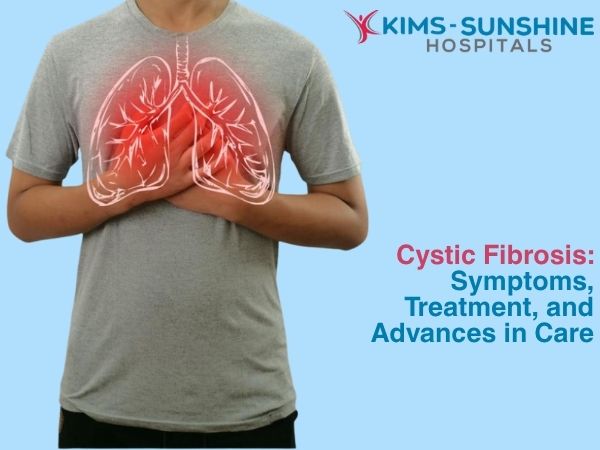
Cystic Fibrosis: Symptoms, Treatment, and Advances in Care
 Cystic fibrosis is a genetic disorder characterised by loss in function of an important gene called the CFTR (cystic fibrosis transmembrane conductance regulator), which is in turn used to form a protein called CFTR protein. The main function of such transmembrane proteins is to ensure proper ionic and fluid transport to and from cells. When this gets disrupted, less fluid is used to synthesise mucus, which then becomes very thick and sticky. This also means that such mucus won’t get cleared easily and instead will clog various pathways in the body, hindering digestion and breathing mainly, among other bodily processes. The incidence of CF is pretty high in India, but millions of cases go undiagnosed every year- either due to poor awareness or the inability to get newborn screening done soon after birth.
Cystic fibrosis is a genetic disorder characterised by loss in function of an important gene called the CFTR (cystic fibrosis transmembrane conductance regulator), which is in turn used to form a protein called CFTR protein. The main function of such transmembrane proteins is to ensure proper ionic and fluid transport to and from cells. When this gets disrupted, less fluid is used to synthesise mucus, which then becomes very thick and sticky. This also means that such mucus won’t get cleared easily and instead will clog various pathways in the body, hindering digestion and breathing mainly, among other bodily processes. The incidence of CF is pretty high in India, but millions of cases go undiagnosed every year- either due to poor awareness or the inability to get newborn screening done soon after birth.
Early Signs And Symptoms Of Cystic Fibrosis In Children
Cystic fibrosis is normally diagnosed easily at birth, if the child gets newborn screening done. This test checks for certain proteins and enzymes and the levels at which they are present can indicate any underlying medical condition. For CF, a protein called IRT (Immunoreactive Trypsinogen) is looked at specifically. High levels indicate CF, while low levels mean the child is fine.
If the child has never given a blood sample before, but is showing these symptoms, then you need to get them checked immediately
- Severe congestion in the nose and having a hard time breathing
- Wheezing
- Very smelly and greasy stools
- Being constipated or having severe diarrhoea
- A metallic tang on the skin, with very salty sweat
How Is Cystic Fibrosis Diagnosed And Treated?
The incessant production of very thick mucus makes it very hard for your body to clear it, resulting in scarring and fibrosis- which is why it is termed ‘cystic fibrosis’. CF is first diagnosed if newborn screening is done, but otherwise, done through the following tests-
- Sweat tests check how much chloride is present in your sweat sample. High levels mean positive for CF.
- Chest x-rays are also done along with lung function tests to ascertain severity of scarring
- Sputum or mucus culture to check for which bacteria are present in them
- A biopsy of the pancreas to check for cysts or fibrosis
- To check for chloride ion levels in the rectum- called the Intestinal Current Measurement test.
Treatment normally involves giving medications that help thin mucus down, bronchodilators to help you breathe easier, CFTR modulators, antibiotics, anti-inflammatory drugs, inhaled hypertonic saline solution and stool softeners or laxatives to help you live better. These are some of the best medications for managing cystic fibrosis symptoms, as CF is a chronic condition that cannot be cured.
Life Expectancy And Prognosis For Cystic Fibrosis Patients
Life expectancy has greatly improved in the last 3 decades, from a median age of 28 to early 60s and beyond at present. This is because more drugs are available and doctors understand the condition better. CFTR modulator therapies in particular have helped a lot. Doctors are also more aware of breathing and coughing techniques which can help a person improve their quality of life. Since it is not curable, managing symptoms becomes very important. If it gets too severe and the person can’t breathe at all, then a lung transplant may be recommended. When this isn’t possible, death is inevitable.
Conclusion
Researchers have been toying with the idea of gene therapy and other future treatments for cystic fibrosis. They are currently being tested on human volunteers in well established clinical trials. Gene therapy essentially aims to send in correct proteins or copies of the CFTR gene so that the correct protein can be made. If done properly, then the mutant or defective genes get overpowered by the injected genes which are in the right configuration. But, this transport of the gene and ensuring it enters cells and then works properly is a major issue of contention. Scientists are trying to figure out if using viruses is a good idea for this or not. Until the right vector or vehicle is used, gene therapy will remain a distant dream.






